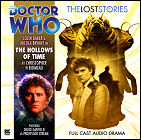 The Doctor and Peri have a difficult time remembering their latest adventure, but bit by bit, details come back to them: they visited the quaint village of Hollowdean in the early 1980s, with the Doctor planning to visit the Reverend Foxworth, formerly a Bletchley Park artificial intelligence expert who worked with Alan Turing on early computer technology. But Foxworth hasn’t abandoned his penchant for creating new technology, and that has the Doctor worried. Also worrying is the hold that self-styled religious guru Professor Stream has over the entire village. Peri befriends a local boy named Simon, who shows her a piece of a scaly carapace – a fragment that the Doctor instantly recognizes as part of the outer shell of a Tractator, an alien species he once met who can influence gravity. Peri and Simon discover that the Tractators are being enslaves for their unique gravitational properties, but whoever has trapped them needs something that only the Doctor can provide: a working TARDIS, and the coordinates of the Gravis, the most powerful of the Tractators.
The Doctor and Peri have a difficult time remembering their latest adventure, but bit by bit, details come back to them: they visited the quaint village of Hollowdean in the early 1980s, with the Doctor planning to visit the Reverend Foxworth, formerly a Bletchley Park artificial intelligence expert who worked with Alan Turing on early computer technology. But Foxworth hasn’t abandoned his penchant for creating new technology, and that has the Doctor worried. Also worrying is the hold that self-styled religious guru Professor Stream has over the entire village. Peri befriends a local boy named Simon, who shows her a piece of a scaly carapace – a fragment that the Doctor instantly recognizes as part of the outer shell of a Tractator, an alien species he once met who can influence gravity. Peri and Simon discover that the Tractators are being enslaves for their unique gravitational properties, but whoever has trapped them needs something that only the Doctor can provide: a working TARDIS, and the coordinates of the Gravis, the most powerful of the Tractators.
written by Christopher H. Bidmead
directed by John Ainsworth
music by Nigel FairsCast: Colin Baker (The Doctor), Nicola Bryant (Peri), David Garfield (Professor Stream), Trevor Littledale (Reverend Foxwell), Susan Sheridan (Mrs. Streeter), Hywel John (Steel Specs), Victoria Finney (Jane)
Notes: The Hollows Of Time was originally submitted by former Doctor Who script editor Christopher H. Bidmead; in addition to writing Logopolis and Castrovalva, he also wrote Frontios, the fifth Doctor story that introduced the Tractators and the Gravis. The Doctor accesses an “old computer” in part two, which is somehow capable of emitting modern Windows event sounds.
Timeline: after Leviathan and before Paradise Five
LogBook entry and TheatEar review by Earl Green
Review: Originally commissioned as a script for the abandoned 1986 season of Doctor Who (which was eventually replaced with The Trial Of A Time Lord), The Hollows Of Time has all the hallmarks of Christopher H. Bidmead’s other scripts for the series – an interesting setup let down by convoluted, overly-complicated technobabble. With or without the substitutionk of the Trial for the 1986 season, this is one of those Lost Stories where it’s easy to see why it was lost.
The characters are endearing. Reverend “Foxy” Foxworth is an interesting character, leaving one to wonder just what the Doctor was doing hanging around at Bletchley Park with Foxworth and Turing. (Helping out quietly, one imagines.) Slightly annoying but still endearing is the character of Simon, who seems like ideal companion material other than his young age (though adding him to the show full-time – had Hollows been filmed and broadcast – would’ve been the height of folly), and there’s even a refernce made to this toward the end of the story. Professor Stream and his minions are fascinating characters as well. It’s an interesting cast of characters played by a more-than-competent cast.
The script, ultimately, is what rings hollow. The technobabble in part two is off-the-scale, crowding out that interesting cast of characters with Tractator sightings (not an enemy that ever needed to be brought back), time corridors, and talk of a reality-threatening gravitational gizmo. There’s a pointless voyage into the recent past where our heroes must avoid being seen by themselves yesterday, and, silliest of all, a time corridor that leads Peri and Simon into… the TARDIS time rotor?
But even that isn’t the script’s worst sin: the framing scenes, in which the Doctor and Peri are trying to regain their memory of the events, not only take up precious time but advance the plot by leapfrogging past events via in-character narration. It’s easy to get the impression that the whole thing wasn’t thought out very well in advance, and that the quantum leaps via narration are convenient bridges covering plot holes.
It’s probably a good thing that The Hollows Of Time wasn’t made for television; after spending two hours listening to it, it’s not hard to wish that it hadn’t been made for audio either. This is easily one of the weakest Lost Stories.


